An experiment with sids and sooans
Sooans is something people in the past made in order to utilise absolutely every bit of nutrition that could be squeezed out of their grain. For me, it all started when my friend Neil Leask came by with a sack full of husks – or “sids” as they are better known – that he had gotten from a friend. And now he challenged me to make sooans. I rarely say no to a challenge.
The word sooans itself is spelled in several different ways: I have seen “sowans” or “sowens” or “sooins” and more. The etymological origin is Gaelic. According to the Dictionary of the Scots Language, the Gaelic wordsubhanmeans “water impregnated with the juice of corn-seeds, of which a coagulated kind of food, called sowens, is made”. In Irish, the correspondingsúghánmeans “sap, juice, moisture”. The “sids” (also sometimes spelled “suds”), on the other hand, is according to the Dictionary of the Scots Language a northern form of the word “seeds”. It says that the reason the vowel is shortened is probably due to reduction in unaccented position as the second element in a combination such as “aitseed” (oat seed). JakobJakobsen in his Etymological Dictionary of the Norn Language in Shetland attempts to make an etymological connection with Icelandic “suddi”, meaning “fine rain”. However, the Dictionary of the Scots Language comments that this connection is difficult on phonological grounds, and I personally think it sounds a bit far fetched regarding the meaning of the words too.
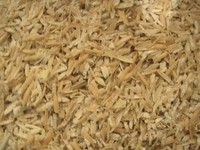
The sids. Copyright Ragnhild Ljosland
Neil didn’t only come with sids, he also collected recipes for how to make the sooans and for things to bake with it afterwards from more knowledgeable people than us. So this is how to do it:
Ingredients:
- 1/4st Oatmeal sids
- 3/4lb OatmealBlood heat water
Method:
- Adding sids, oatmeal and water time about, make a thick water mixture
- Let stand for 10-14 days
- Strain through a sieveSieve and re-sieve the liquid until all the husk is gone
- Leave resulting liquid in a jar until all the water comes to the top, approximately 2 days
- Replace the water with clean water
- Pour off the water before using the sooans
- Cover with cold water after each time used.
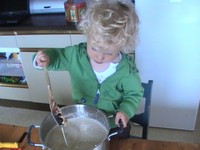
Mixing sids with water. Copyright Ragnhild Ljosland
Well, it didn’t say how much water to use, but I figured that it has to cover the sids quite well so I used about five litres. I later discovered that it is very important that none of the sids stick up out of the water. The sooans was brewing away fine in the garage, but after ten days, when I was just thinking it will be about time to start sieving it, my experiment suffered a major setback: It had gone green-nild on top!! It looked horrible and I started to think that I would have to abandon the experiment and throw it away when I discovered that it was only the sids that had been sticking out of the water which had gone mouldy. All the stuff underneath was fine after I took the top layer off.
In the case of green-nild, by the way, my three trusted dictionaries all disagree on the etymology. The Dictionary of the Scots Language says that “blue-nild” is a turned around way of saying “Nile Blue”, as in the blue colour of the river Nile. And it is true, right enough, that Orkney dialect has many turned around expressions, such as “ootside-in” or “heid-light”. However, this explanation doesn’t take “green-nild” into account, and it is also difficult for me to imagine why Orkney folk would refer to the river Nile in the first place. So I went to Jakobsen’s dictionary, which makes a connection with a Faroese word “næla”, meaning “to shoot forth with small sprouts, of grain, seed, hair, etc.” Since I was still not convinced, I went to Hugh Marwick’s dictionary, which provided the best explanation yet: The “n” in “nild” has replaced an “m”, making the word cognate with the Norwegian word “mygla”, meaning to go mouldy. This word may also be prefixed with the colour of the mould, such as “blåmygla” (blue-nild) or “grønnmygla” (green-nild). I understood that it was probably too long to leave the sooansidsto steep for two whole weeks and in any case it is definitely important to have it well covered in water.
Anyway, once the now steeped sooans was rescued, the next step was to sieve it – or sye it, as Neil said, thereby using a word which according to the Dictionary of the Scots Language has been obsolete in English exceptin dialectal use since the 17th century.
The sying process was more strenuous than I had thought. The steeped sids had to be squeezed into the sieve, and out on the other side came a thick, off-white liquid looking like quite runny yoghurt or thick pancake mixture, called the “drinking-sooans”.
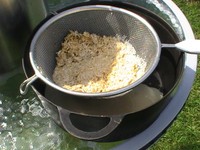
Sieving the sids out of the sooans. Copyright Ragnhild Ljosland
The next step was to throw away the now empty sids, cover the yoghurty liquid with some fresh water, and leave it to settle for a couple of more days until all the thick stuff had sunk to the bottom. The stuff at the bottom was now really thick and creamy, almost like ice-cream which is starting to melt. I poured off the liquid on top, called “swatts”, which in Scots is also used to describe newly brewed, weak beer.
It smelt sour in a very suspicious way. Perhaps my modern and rather spoiled taste-buds were making stronger protests than what was actually called for. My husband was equally suspicious: “Don’t eat it! What if you go blind! Or contract some horrible, mediaeval disease!” “Can I quote you on that in my column?” I said. “Are you saying folk will think I’m a coward?” he said. “I’ll tell you what: They will say I have a point! There was a case where a whole village fell ill after eating mouldy grain!” I tasted some anyway, concluded that it tasted awful, and when I woke up the next morning feeling somewhat dizzy, my husband got really worried. However, as you can tell, I survived with no lasting injury. According to a 1693 source, “sowens are good victuals both for body and saul”.And in Orkney it was traditionally also used as medicine for sore tummies, I was told.
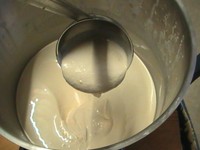
The thick, youghurty sooans. Still quite runny. It sets after a while. Copyright Ragnhild Ljosland
The sooans can now be “preserved for months by pouring off the clear “swatts” and adding fresh water” says John Firth in his Reminiscences of an Orkney Parish. This is handy, because you can use it for several kinds of baking and dishes. The easiest dish is prepared simply by boiling the sooans with water and salt. This can then be eaten like porridge. Other recipes are sooans scones and sooans pancakes, which Neil had brought me recipes for. I decided to try some sooans pancakes:
Ingredients:
- 1 cup plain flour
- ½ tsp baking soda
- Pinch of salt
- Sugar to taste
Make into a pancake batter with buttermilk (that is, low fat milk)
Add 2 ladles of sooans
Thin down with buttermilk
Bake on a fairly hot girdle (I used the frying pan)
Neil turned out to have a personal interest in sooans: Sooans very nearly caused him not to be born in the first place. As a young child, Neil’s father had a strong liking for sooans. One day at his home farm in Rendall, Neil’s father was overcome by temptation and decided to have a sup of the sooans, which was kept in a large cream jar in the milk hoose. Nobody noticed he was missing until the servant lass who was helping out found that it had gone rather quiet and went to look for him. And what did she see? Two little feet sticking out – The boy had fallen head first in the sooansjar, and now there were bubbles coming up! The girl didn’t hesitate, but grabbed the little boy by the legs and pulled him out, thereby saving him from drowning. The girl’s name was Margaret Taylor, and was affectionately known as Mada. At a dance the other week Neil introduced her daughter to me as “This is the daughter of the lady who saved my father’s life when he nearly drowned in the sooans!”
Ernest Marwick for many years kept a column in The Orkney Herald called SooanSids. I don’t know why he chose that name – perhaps some of the readers could tell me? – but I figured it makes sense. Because Ernest Marwick collected stories and folklore and customs and traditions that many people would perhaps not have regarded as valuable at that time – “what is he wantan tae ken aboot that for?”. But Ernest Marwick saw the value of these “sids” of information, and in his collection work and his writing he showed that it was actually both interesting and valuable. So one shouldn’t disregard sooansids!
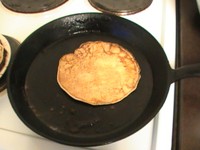
The finished sooans pancake. Copyright Ragnhild Ljosland